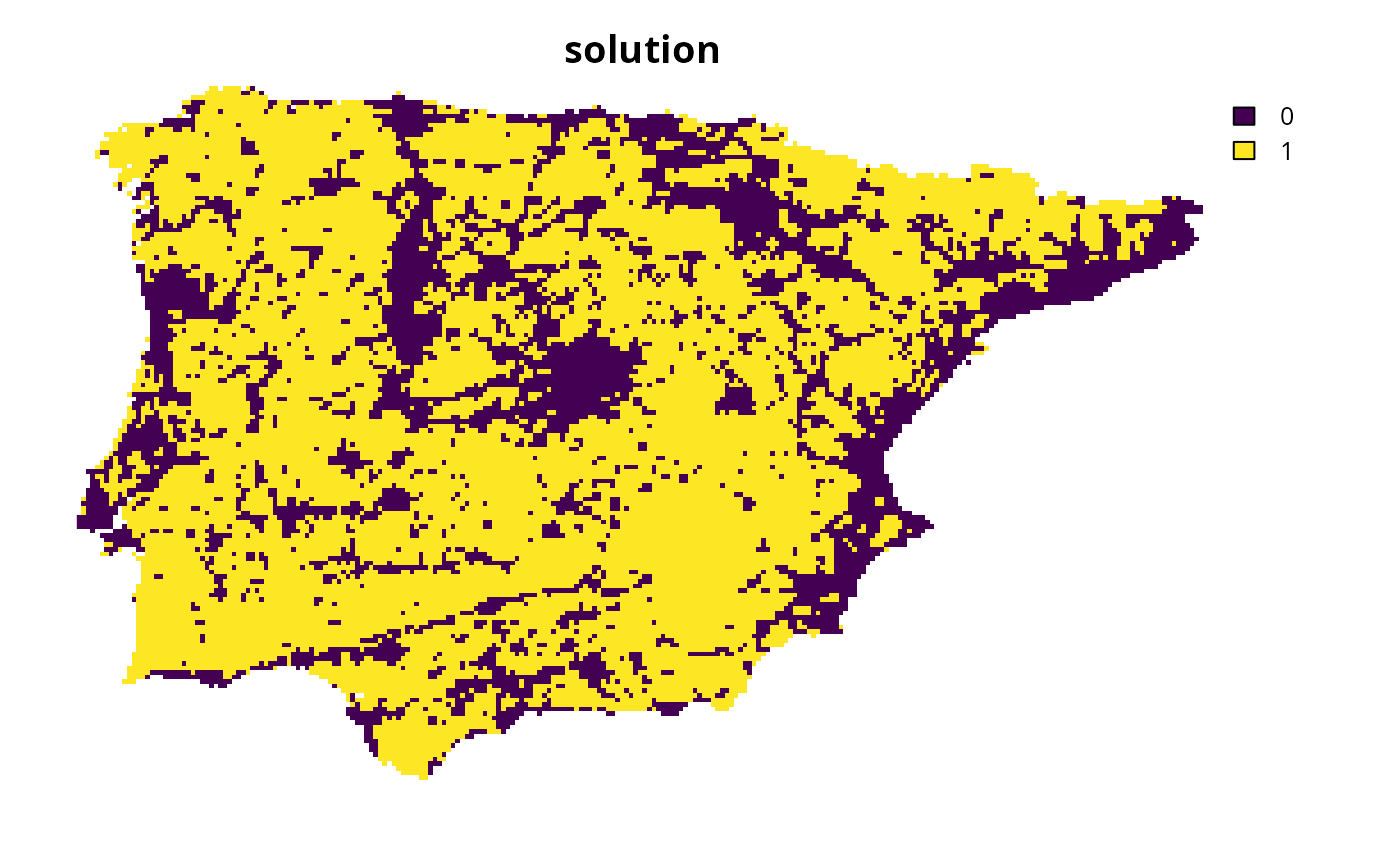Specify targets based on the methodology outlined by
Jung et al. (2021).
Briefly, this method involves setting targets based the criteria
for recognizing Vulnerable species by the International Union for the
Conservation of Nature (IUCN) Red List of Threatened Species (IUCN 2025).
To help prevent widespread features from obscuring priorities,
targets are capped following Butchart et al. (2015).
This method was designed for global-scale prioritizations.
Note that this function is designed to be used with add_auto_targets()
and add_group_targets().
Usage
spec_jung_targets(
status = "VU",
prop_uplift = 0.1,
cap_area_target = 1e+06,
area_units = "km^2"
)Arguments
- status
charactervalue denoting the IUCN Red List threat status used for target setting. Available options include"CR"(Critically Endangered) ,"EN"(Endangered), and"VU"(Vulnerable). Defaults to"VU".- prop_uplift
numericvalue denoting the percentage uplift as a proportion. Defaults to 0.1 (i.e., 10%).- cap_area_target
numericvalue denoting the area-based target cap. To avoid setting a target cap, a missing (NA) value can be specified. Defaults to 1000000 (i.e., 1,000,000 km2).- area_units
charactervalue denoting the unit of measurement for the area-based arguments. Defaults to"km^2"(i.e., km2).
Value
An object (TargetMethod) for specifying targets that
can be used with add_auto_targets() and add_group_targets()
to add targets to a problem().
Details
This target setting method was designed to protect species in global-scale prioritizations (Jung et al. 2021). Although it has been successfully applied to multiple global-scale prioritizations (e.g., Mogg et al. 2019; Fastré et al. 2021), it may fail to identify meaningful priorities for prioritizations conducted at smaller geographic scales (e.g., national, state-level, or county scales). For example, if this target setting method is applied to smaller geographic scales, then the resulting prioritizations may select an overly large percentage of the study area, or be biased towards over-representing common and widespread species. This is because the target thresholds were developed based on criteria for promoting the long-term persistence of entire species. As such, if you are working at smaller scales that do not fully cover the entire spatial distribution of the study species, then you may need to rescale these targets (e.g., based on the proportion of the species' distribution found within the study area) or consider an alternative target setting method. Please note that this function is provided as convenient method to set targets for problems with a single management zone, and cannot be used for those with multiple management zones.
Data calculations
This function involves calculating targets based on the spatial extent
of the features in x.
Although it can be readily applied to problem() objects that
have the feature data provided as a terra::rast() object,
you will need to specify the spatial units for the features
when initializing the problem() objects if the feature data
are provided in a different format. In particular, if the feature
data are provided as a data.frame or character vector,
then you will need to specify an argument to feature_units when
using the problem() function.
See the Examples section of the documentation for add_auto_targets()
for a demonstration of specifying the spatial units for features.
Mathematical formulation
This method involves setting target thresholds based on assessment criteria from the International Union for the Conservation of Nature (IUCN) Red List of Threatened Species (IUCN 2025). In particular, it considers criteria related to the size of a species' spatial distribution (i.e., Criterion B2) and population size reduction (i.e., Criterion A2) and applies a percentage-based uplift to them. By default, it considers criteria for the Vulnerable threat status with a 10% uplift and involves setting the target threshold for a species as 2,200 km2 or 80% of its spatial distribution (which ever value is larger). Additionally, following Butchart et al. (2015), a cap of 1,000,000 km2 is applied to target thresholds.
References
Butchart SHM, Clarke M, Smith RJ, Sykes RE, Scharlemann JPW, Harfoot M, Buchanan GM, Angulo A, Balmford A, Bertzky B, Brooks TM, Carpenter KE, Comeros‐Raynal MT, Cornell J, Ficetola GF, Fishpool LDC, Fuller RA, Geldmann J, Harwell H, Hilton‐Taylor C, Hoffmann M, Joolia A, Joppa L, Kingston N, May I, Milam A, Polidoro B, Ralph G, Richman N, Rondinini C, Segan DB, Skolnik B, Spalding MD, Stuart SN, Symes A, Taylor J, Visconti P, Watson JEM, Wood L, Burgess ND (2015) Shortfalls and solutions for meeting national and global conservation area targets. Conservation Letters, 8: 329–337.
Fastré C, van Zeist W-J, Watson JEM, Visconti P (2021) Integrated spatial planning for biodiversity conservation and food production. One Earth, 4:1635–1644.
IUCN (2025) The IUCN Red List of Threatened Species. Version 2025-1. Available at https://www.iucnredlist.org. Accessed on 23 July 2025.
Jung M, Arnell A, de Lamo X, García-Rangel S, Lewis M, Mark J, Merow C, Miles L, Ondo I, Pironon S, Ravilious C, Rivers M, Schepaschenko D, Tallowin O, van Soesbergen A, Govaerts R, Boyle BL, Enquist BJ, Feng X, Gallagher R, Maitner B, Meiri S, Mulligan M, Ofer G, Roll U, Hanson JO, Jetz W, Di Marco M, McGowan J, Rinnan DS, Sachs JD, Lesiv M, Adams VM, Andrew SC, Burger JR, Hannah L, Marquet PA, McCarthy JK, Morueta-Holme N, Newman EA, Park DS, Roehrdanz PR, Svenning J-C, Violle C, Wieringa JJ, Wynne G, Fritz S, Strassburg BBN, Obersteiner M, Kapos V, Burgess N, Schmidt- Traub G, Visconti P (2021) Areas of global importance for conserving terrestrial biodiversity, carbon and water. Nature Ecology and Evolution, 5:1499–1509.
Mogg S, Fastre C, Jung M, Visconti P (2019) Targeted expansion of Protected Areas to maximise the persistence of terrestrial mammals. Preprint at bioxriv, doi:10.1101/608992 .
See also
See targets for an overview of all functions for adding targets.
Other target setting methods:
spec_absolute_targets(),
spec_area_targets(),
spec_duran_targets(),
spec_interp_absolute_targets(),
spec_interp_area_targets(),
spec_max_targets(),
spec_min_targets(),
spec_polak_targets(),
spec_pop_size_targets(),
spec_relative_targets(),
spec_rl_ecosystem_targets(),
spec_rl_species_targets(),
spec_rodrigues_targets(),
spec_rule_targets(),
spec_ward_targets(),
spec_watson_targets(),
spec_wilson_targets()
Examples
# \dontrun{
# set seed for reproducibility
set.seed(500)
# load data
sim_complex_pu_raster <- get_sim_complex_pu_raster()
sim_complex_features <- get_sim_complex_features()
# create problem with Jung et al. (2021) targets
p1 <-
problem(sim_complex_pu_raster, sim_complex_features) %>%
add_min_set_objective() %>%
add_auto_targets(method = spec_jung_targets()) %>%
add_binary_decisions() %>%
add_default_solver(verbose = FALSE)
# solve problem
s1 <- solve(p1)
# plot solution
plot(s1, main = "solution", axes = FALSE)
 # }
# }
